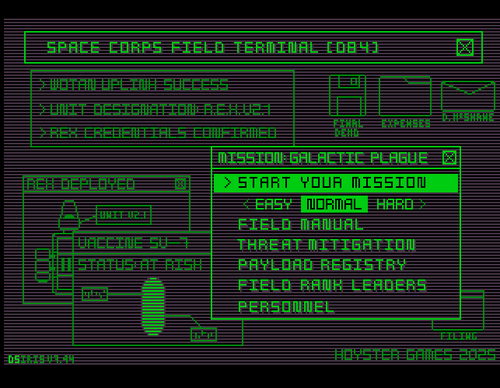Thanks for the Memory

If I’d had any experience of game development—or even planned things properly from the start—then the last month or so might have gone a little differently.
Rex and the Galactic Plague is essentially complete. Since the March demo, I’ve built out the final levels, polished the rough edges, and reached a point where I could have called it done. It wasn’t quite running on a base A500+, but I figured I’d sort that out later.
But then… I had ideas.
First, the weapons. The original setup—two upgradable weapons—meant you could max out by the end of level two and coast the rest of the game. That felt flat. So, in the space of a few days, I rebuilt the system: nine weapons (including the standard laser) and five defensive items, each with its own logic, graphics, availability, and balancing quirks. Testing, tweaking, nerfing—it took time, but the result was far more satisfying.
Then came the endings. I’d already created a “good” and “bad” route, determined by the player’s actions. But I wanted to do more with that. Route A now leads to a small new level, and—because fairness matters—Route B got its own alternate version too. With the tools in Scorpion now second nature, I went from concept to implementation in a day.
With all that in, and a new high score table added, I could have released the whole thing. Rex and the Galactic Plague now runs brilliantly on an A500 with 1MB fast RAM, or on a stock A1200.
But not on my A500+.
I know most people will play on emulators. It doesn’t really matter. But I’m not making this game for most people. I’m making it for me. And the thrill of loading a game I made on real hardware, from a real disk, into my beloved machine—that’s too important to lose.
If I’d known what I was doing from the start, I’d have designed everything around that goal. But I didn’t. So I’ve spent the last few weeks cutting, slimming, and reorganising to build a new demo that fits the limits.
Some of the changes made things better: cutting down panel colours inspired a green-screen VDU aesthetic that visually pulled the game together. I’ve learned a lot about how to build more efficiently. But there have been compromises too—split levels, longer loading pauses, and some changes to pacing and enemy placement.
Still—it worked. The latest demo, with the first three levels, runs perfectly on my A500+. Seeing that VDU aesthetic light up the CRT? Totally worth it.
Since then, I’ve folded in level four, and I’m now tackling level five. The biggest challenge lies ahead: level six. It’ll need to be split across four maps. The intermission stages and final level are small, but space is getting tight.
And I’m coming to accept that maybe, just maybe, I won’t be able to fit everything into the base A500 build.
So most likely, there will be two versions of Rex:
- One for unexpanded A500s—pared back, but true to the vision.
- One full-fat build—for machines with more memory, including all the bells, whistles, story screens, and seamless levels.
In the meantime, I’ll keep building and trimming and squeezing as much magic into the base build as I can.
Wish me luck as I tackle the biggest levels in the game.
As the Seventh Doctor once said: “Time will tell. It always does.”
Files
Get Rex and the Galactic Plague
Rex and the Galactic Plague
A new Scorpion Engine game for the Commodore Amiga
| Status | In development |
| Author | HoysterGames |
| Genre | Shooter |
| Tags | Amiga, commodore-amiga, doctor-who, Pixel Art, retro-game, Sci-fi, scorpion-engine, Shoot 'Em Up, Singleplayer, vertical-shooter |
More posts
- Rex reaches the final stretch18 days ago
- A lesson learned the hard way - but I got there in the end95 days ago
- Rex and the Galactic Plague - demo updateFeb 22, 2025

Leave a comment
Log in with itch.io to leave a comment.